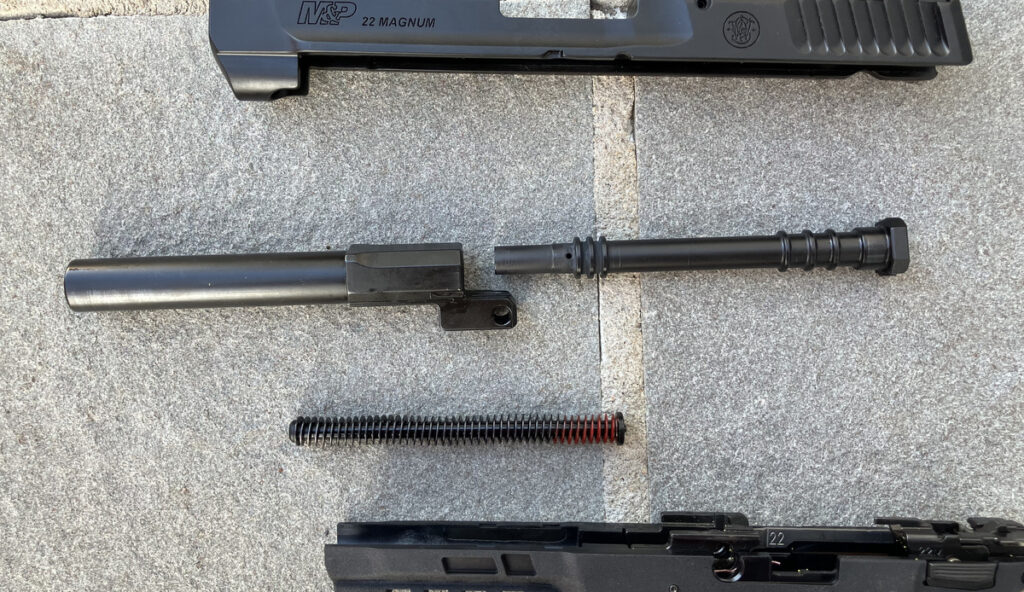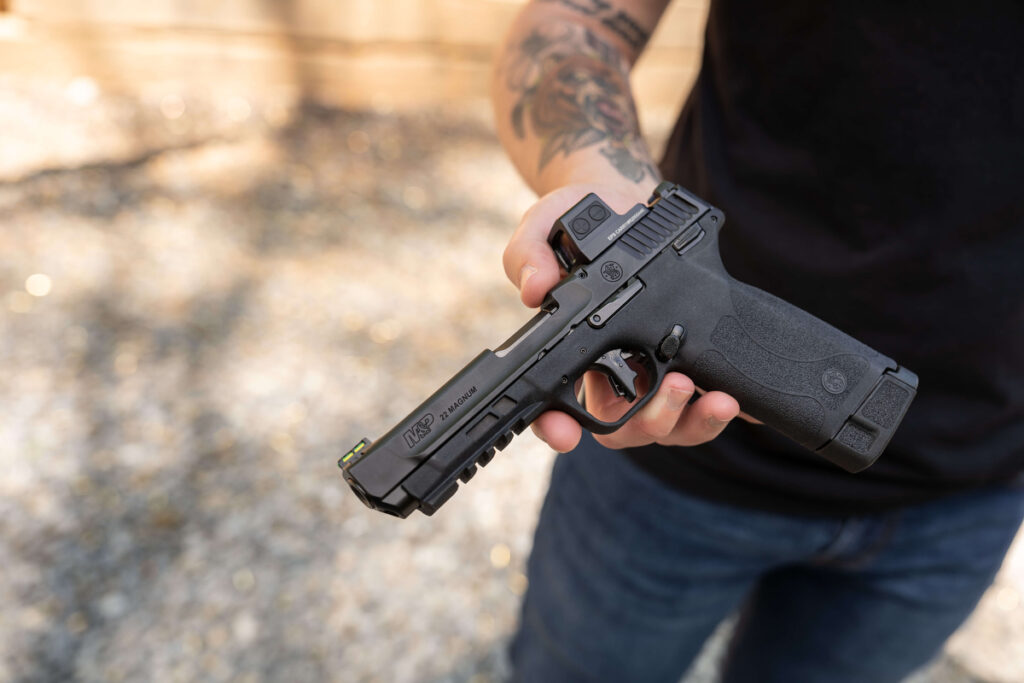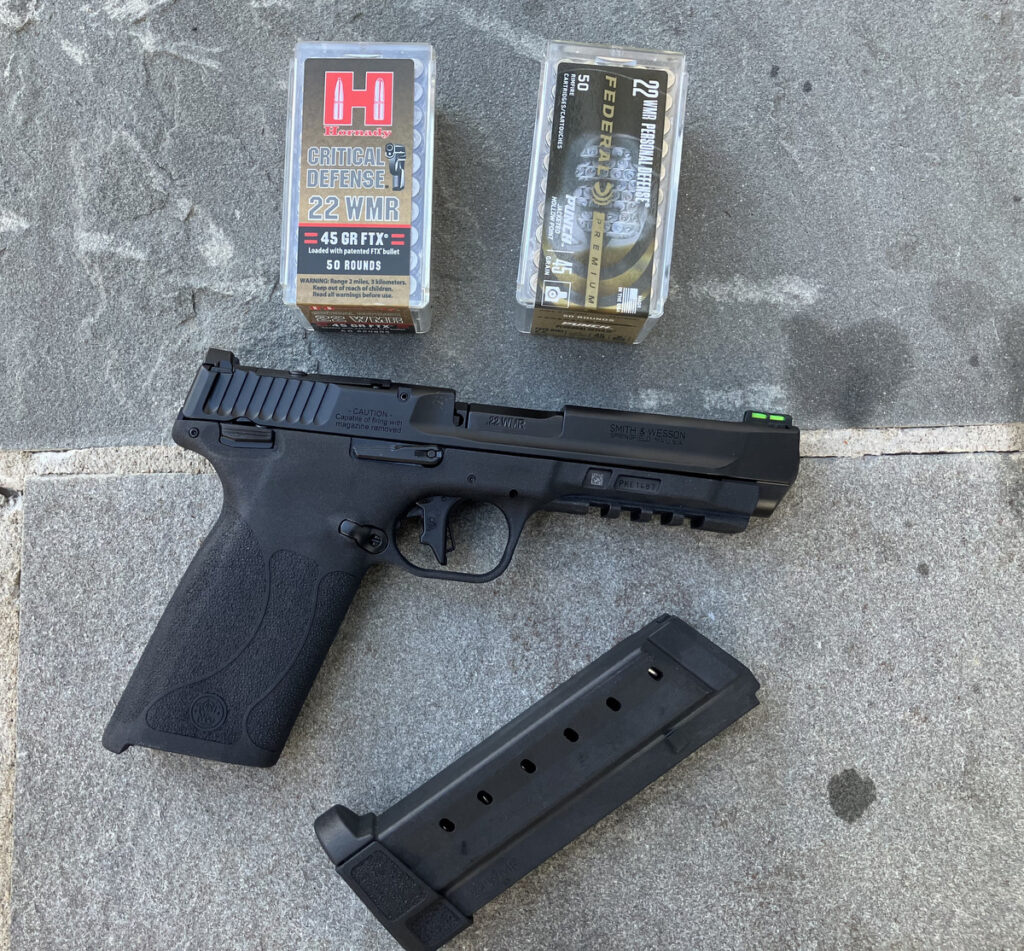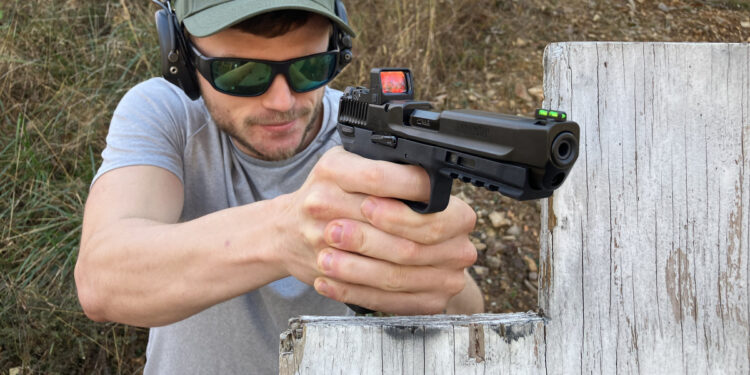By Todd Burgreen
The Smith & Wesson M&P 22 Magnum surprised many a firearm pontificator when it arrived earlier this year. Most didn’t see it coming since it doesn’t seem to fill a particular niche in the market. And, while it might be a gun without a clear role, it’s one that we can evaluate without any preconceived notions. Can it serve as an understudy to centerfire handguns? Sure. However, it does not directly mimic any other weapon out there besides its own M&P 5.7 stablemate, which is its own unicorn. How about outright personal defense? Sure. 30 rounds of 22 Magnum is not to be taken lightly, especially as ammunition potency is improved on. Trail gun? Sure. This is probably the most described role considering the M&P 22 Magnum’s light weight (22 ounces) and high capacity (30 rounds). Plinking or target shooting? Absolutely, considering its lack of recoil, flat-faced trigger, and ability to mount a red dot optic for further sighting enhancement. Any trigger time is good trigger time.

Sometimes you just have to go with it and not ask why. That’s the sort of impression that the new M&P 22 Magnum semi-auto generates. Who doesn’t like thirty rounds in a lightweight handgun that can spit them out as fast as you can pull the trigger? The M&P 22 Magnum defies easy categorization. It rejects being labeled as an understudy. It easily separates itself from the competition with its 22 WMR chambering and ultra-high capacity.
While the M&P 22 Magnum’s muzzle blast will surprise you with a signature more typical of a centerfire cartridge, recoil is minimal, though, and thus manageable by all shooters. Though popular as a manually operated rifle and revolver round, few manufactures attempt to build a semi-auto rifle or handgun in 22 WMR. This stems from various reasons including 22 WMR cartridge length standards, case rim specifications, and variations in pressure levels of different brands of 22 WMR ammunition. Each of which provided S&W engineers a chance to shine in problem solving. S&W decided to tackle these issues in creating the M&P 22 Magnum. Additional features further adds credence to its uniqueness.
INNOVATION
S&W engineers had to pay special attention to magazine design with the M&P 22 Magnum. Afterall, what good is 30 rounds of firepower if not capable of being sent downrange when needed. The magazine can be described as pie shaped with the tapered end toward the bullet nose. S&W’s manual describes proper loading procedures to help in reliable operation. The requirements are not onerous. The rimmed case is inserted into a segment of the magazine lips before being pushed to the rear of the magazine. After every five or so rounds are loaded, the magazine is to be tapped on something solid such as palm or table to help seat the rims into the magazine without getting out of orientation sequence. The rim of the 22 Magnum round sitting on top of its neighbor must be kept in front. The magazine loading method is straightforward and does not take any more time to complete than random jamming of rounds into any other magazine.

One of the potential issues with 22 WMR semi-automatic pistols is the wide range of pressures generated by factory ammunition. The S&W TEMPO operating system addresses this with its combination recoil/gas assist design. It allows the S&W M&P22 Magnum to reliably fire a wide variety of ammunition.

The S&W TEMPO design is a gas-operated, locked-breech operating system. It was initially unveiled with the S&W M&P 5.7 pistol. The TEMPO system is more of a hybrid recoil gas assist design. A gas port near the muzzle funnels gas rearward between the barrel and surrounding shroud/sleeve. The barrel is surrounded by a shroud. A gas port vents gas into the shroud to interact with the barrel. The barrel has six radial piston rings (three slim ones out by muzzle and thicker ones towards the breech) that regulate gas flow. After initial backward movement of slide, the port siphoned-off gas finishes barrel movement rearward, causing it to encounter a lug in the frame, unlocking the barrel from the shroud and slide to finish the recoil process.
DETAILS
The S&W M&P 22 Magnum is a semi-automatic, internal hammer fired pistol with a 4.3-inch barrel. The overall length is 8.4 inches, and the height is 5.9 inches. The empty weight is only 22 ounces. A loaded magazine weighs a mere 6 ounces. This means that a fully loaded M&P 22 Magnum weighs less than 2 pounds. S&W has installed green fiber optic front and fixed rear sights onto the pistol.
M&P 22 Magnum controls are minimal—flat trigger, ambidextrous safety, and slide lock levers. The dust cover features an integrated Picatinny style rail for attaching lights or other accessories. In front of the rear sight, one will find two screws indicating that S&W has tapped and threaded the slide to accommodate one of the many miniature red dot sights that use the Shield RMSc footprint. Each pistol ships with two magazines and a padded plastic case. As expected, the magazines are constructed of high-strength polymer, similar to the M&P 22 Magnum’s frame.
A BETTER WAY TO CONNECT

A Zero Tech Thrive HD Red Dot Micro Reflex optic was mounted on the M&P 22 Magnum and used for the majority of our evaluation. Weighing only 6 ounces, the Zero Tech Thrive HD Micro Reflex’s features advanced shake awake technology. The Thrive HD projects a 3 MOA dot with ten adjustable brightness levels while offering up to 150,000 hours of runtime with a CR2032 battery. Zero Tech has designed the Thrive HD to be recoil, fog, and waterproof.
The Zero Tech Thrive HD/S&W M&P 22 Magnum combo performed better than expected. The natural pointability of the M&P 22 Magnum comes into its own in this realm with the Zero Tech Thrive HD doing its part. The Thrive HD’s rectangular lens offers a superior field of view compared to other red dot options. The minimal frame of the Thrive HD disappears when focusing on the target with the red dot. The dot is crisp with no halos or disfiguration. The red dot was “there” and seamlessly located at first draw. This is a compliment to the S&W choosing a direct mount method (instead of an adapter plate setup) allowing the Zero Tech to sit as low as possible on the slide. The M&P 22 Magnum’s already low bore axis is further enhanced with a subtle beavertail and undercut trigger guard allowing for a very stable sight picture no matter how many or how rapidly rounds are fired.
TIME TO MAKE NOISE

The S&W M&P 22 Magnum was tested with a myriad of ammunition from Hornady, Winchester, Speer, and Federal, such as Hornady 30-grain V-Max, 45-grain Critical Defense, Federal 45-grain Punch, 40-grain JHP & FMJ, Speer 40-grain GDHP-SB and Winchester FMJ & 45-grain PDX 1 Defender JHP. S&W provides recommendations for ammunition to be used in the M&P 22 Magnum based on its own testing. Range time exhibited all positives in terms of performance and reliability. The trigger pull was a pleasant surprise with minimal creep and light weight required to initiate cartridge ignition. Out RCBS pull weight gauge showed an average of just over 4 pounds after multiple pull tests.
With a 30-round magazine, it did not take long to send large quantities of rounds downrange with many willing volunteers stuffing magazines and running the M&P 22 Magnum’s trigger. Out of over 400 rounds fired, there were a handful of malfunctions. Most of these were traceable to a volunteer not holding the M&P 22 Magnum firmly and high up on the grip. Another anecdote is the surprisingly loud report the M&P 22 Magnum emits. Ear pro should definitely not be ignored. This is based on the 22 WMR being primarily chambered in rifle length barrels, and thus, the use of slower burning powders that do not get consumed in the 4.3-inch barrel. This made firing the pistol more like firing a centerfire defensive handgun minus the associated recoil. Plate racks and other targets strewn around Echo Valley Training Center were engaged repeatedly, as were more traditional paper targets in an effort to get the full sense of the M&P 22 Magnum’s capabilities.

Accuracy with the rimfire S&W M&P 22 Magnum was more than acceptable and probably superior to what most users are capable of when being fired from any non-bench position (which is its raison d’être to begin with.) It was no problem keeping rounds in the “A” zone of the IPSC targets back to 25 yards with the aid of the Zero Tech Thrive HD red dot. It’s very likely that accuracy applies to shots taken from further out as long as users resist the temptation to simple blast rounds downrange knowing thirty 22 WMR rounds are sitting in the magazine awaiting release. Recoil is minimal, though, and manageable by all shooters.
PERFORMANCE
| Avg. FPS | Avg. 5-Shot Group @ 25 yards (in.) | Best 5-Shot Group @ 25 yards (in.) | |
| Federal Punch 45-grain | 1230 | 2.33 | 2 |
| Hornady Vmax 30-grain | 1334 | 2.75 | 2.33 |
| Hornady FTX 45-grain | 1178 | 2.5 | 2.25 |
| Speer GDHP-SB 40-grain | 1290 | 2.75 | 2.25 |
LESS IS BETTER

The 22 Magnum chambering will instantly give it a black mark in terms of terminal ballistic performance. I offer a counterintuitive thought—perhaps the 22 Magnum is an asset in such a lightweight package with so much firepower on board. Let me finish before snorting and scrolling on by.
Compact pistol sales outpace full size handguns and rifles many times over. Manufacturers have answered the call by placing 380 ACP and even 9 mm cartridges into platforms previously reserved for 22 LR, 25 Auto, or 32 ACP chamberings. The wave of new shooters is more than welcome; however, this is a recipe for a poor initial experience when combining such small weapons with stouter recoiling cartridges. Handy-to-carry does not translate into comfortable to shoot. A pistol chambered in 22 Magnum may be more appropriate option for certain sections of the gun-buying public.
Increased 22 Magnum ammunition performance (not an oxymoron) in the 80s was a major reason why 25 ACP chamberings in pocket pistols fell off. It was a surprise to find the number of 22 Magnum loads directed towards the personal defense realm. Hornady and Winchester offer prime examples in the form of Hornady’s 45-grain Critical Defense and Winchester’s 45-grain PDX 1 loads. Speer and Federal weighs in with 40-grain GDHP-SB and 45-grain PUNCH loads for the 22 Magnum. The M&P 22 Magnum chronoed loads across an RCBS chronograph in the 1125-1350 fps range, depending on bullet weights being fired.
MULTI-PURPOSE CAPABLE

As I brought up at the beginning of the article, is the S&W M&P 22 Magnum a candidate for personal defense, a trail/kit gun, target shooter, or dare we say, just for fun? Each user will have to decide what roles the M&P 22 Magnum will fill in their collection. The S&W M&P 22 Magnum’s high capacity and surprisingly light weight is extremely attractive in whatever role it is destined for. Overall, the M&P 22 Magnum is a valid tool offering real world application.
SPECIFICATIONS
| Make: | Smith&Wesson |
| Model: | M&P 22 Magnum |
| Caliber: | 22WMR/22 Magnum |
| Weight (empty): | 22 ounces |
| Overall Length: | 8.4 inches |
| Barrel | 4.35 inches |
| Magazine Capacity | 30 rounds |
| MSRP: | $649 |
| URL: | smith-wesson.com |












